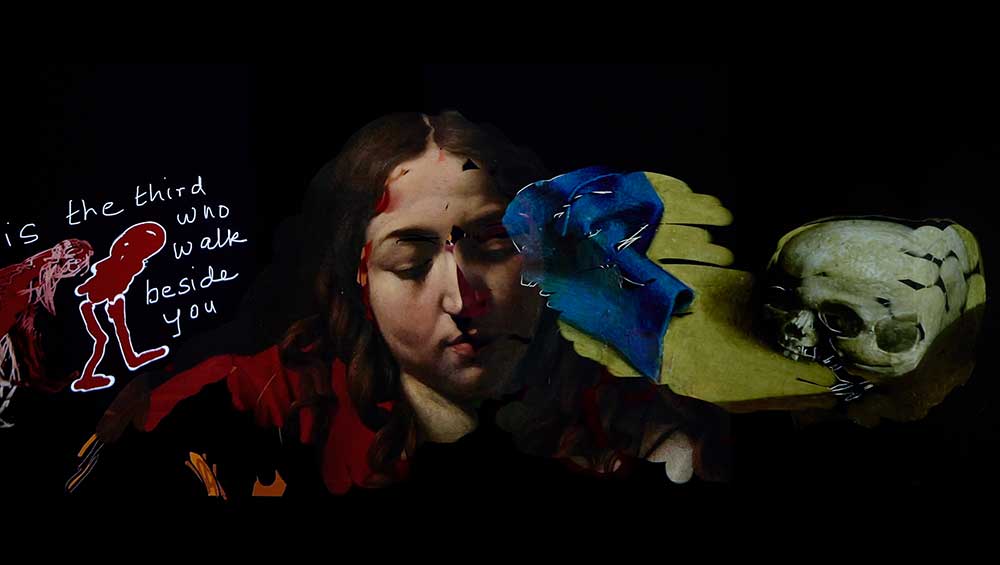
Nalini Malani, My Reality is Different, 2022. © Nalini Malani. Photo: Luke Walker.
National Gallery, London
2 March – 11 June 2023
by BETH WILLIAMSON
Nalini Malani (b1946) is the recipient of the National Gallery’s first contemporary fellowship, and the resulting exhibition, a single artwork titled My Reality Is Different, is nothing short of spectacular. Engaging with paintings from the National Gallery’s collection and that of the Holburne Museum in Bath, Malani has created a monumental work in the form of overlayed video and animation played on a continuous loop in a format of her own making – an animation chamber. The installation here comprises more than 40 metres of wall space, 25 new animations and nine large video projections with accompanying soundscape. It wraps around viewers, or participants, as Malani prefers to call them, sharing the artist’s experience and vision of her selected paintings, reinterpreted and re-presented through her reality.
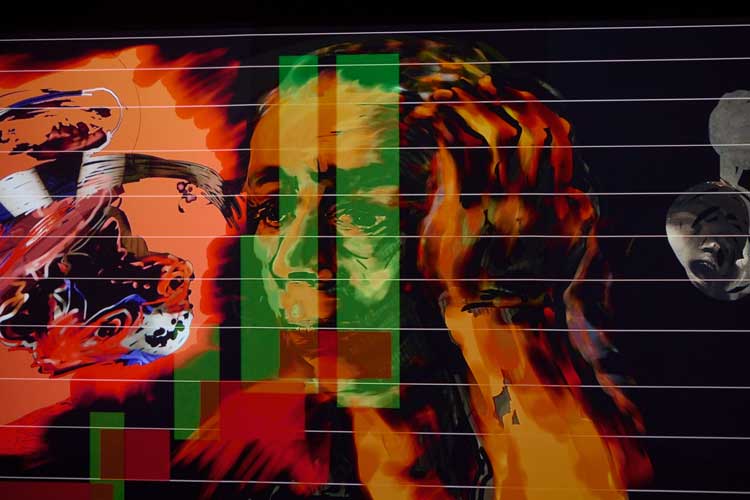
Nalini Malani. My Reality is Different, 2022. © Nalini Malani. Photo: Luke Walker.
The animation chamber – a deep black gallery space in the heart of the National Gallery – is brought alive with Malani’s video projections. The chamber is, as the artist commented during a press conference, the melange of ideas in her head wrought large on the gallery walls. She began working in this way after experimenting with iPad animations, initially shared on Instagram, then projected to establish how robust they were. Her first animation chamber, exploring the horrific story of the violent death of a young girl in India, was Can You Hear Me?, made between 2017 and 2020 and giving a voice to the stories of those, such as this child, marginalised by history. The format itself is something of a continuation of Malani’s constant questioning of the conventions of painting and drawing to reach a wider audience and speak out against oppression.
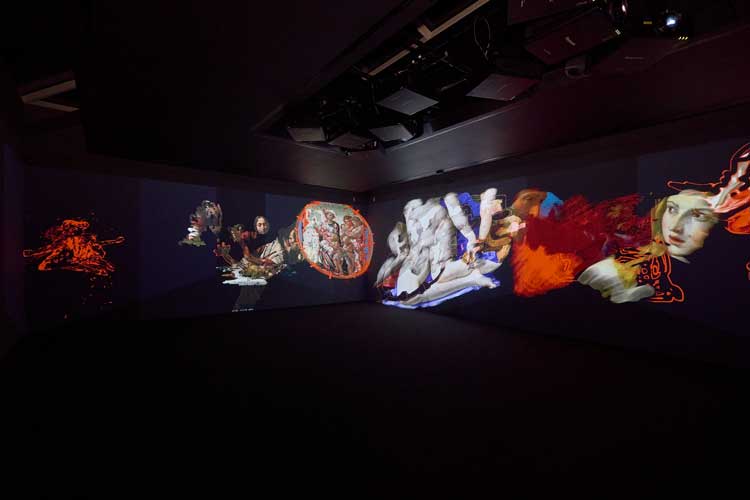
Nalini Malani. My Reality is Different, 2022. © Nalini Malani. Photo: Luke Walker.
My Reality Is Different is based on 25 paintings selected by the artist – three from the collection at the Holburne Museum and 22 from the National Gallery. Malani, who was born in Karachi in 1946, just a year before partition, was already familiar with the National Gallery collection when she took up the fellowship. As former colonisers of India, the British established five art schools and taught a British style. Malani graduated from the Sir JJ School of Art (established by the British in 1857) in Mumbai in 1969, where her practice began with photography, experimental film and abstract painting. Here, she encountered printed images of paintings in the National Gallery. Further, the artist first visited London and the National Gallery aged 16 and has returned every few years since.
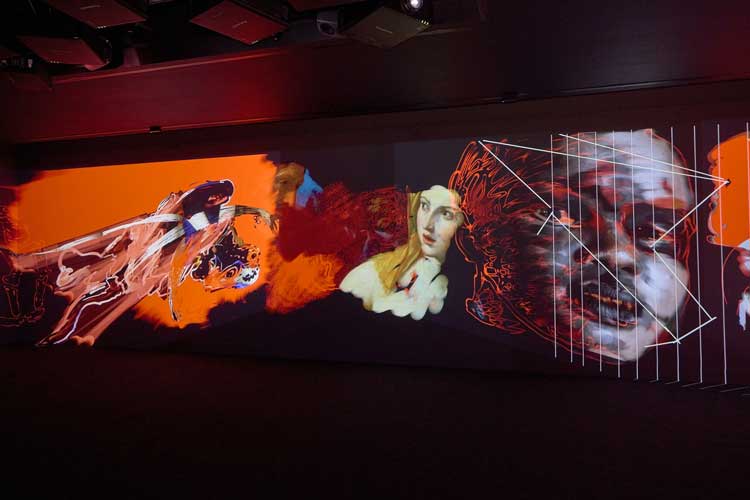
Nalini Malani .My Reality is Different, 2022. © Nalini Malani. Photo: Luke Walker.
For this project, Malani selected paintings of the Greek myths, the old and new testaments of the Bible, and secular paintings. Animations based on these both conceal and reveal, and point in different directions. Entire paintings are never seen, only details, vignettes or quotations, giving participants time to focus on details. Two to four closeup sections are selected from each painting and put together in sequential narrative. The overlay animations were made by Malani on an iPad, her index finger drawing a line on it and making visible her gaze over these pictures in the gallery. The paintings are not sacrosanct and need to be looked at again, she is telling us.
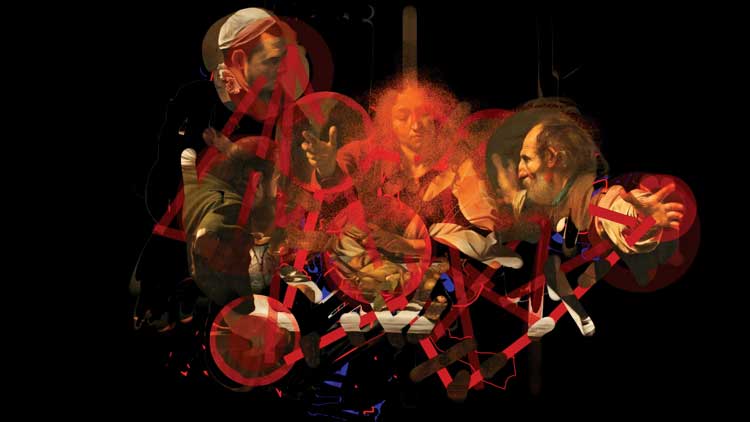
Nalini Malani. My Reality is Different, 2022. Video projection. © Nalini Malani.
Among the fragments of paintings and animations are fictional portraits of Indian and African figures overlayed with financial market graphics, alluding to painful and long-established colonial histories. This extends the artist’s development of what she calls a link-language where a vocabulary of cross-cultural images is used to generate collective meaning. The accompanying audio is the voice of Cassandra, the figure in Greek mythology who foresaw the fall of Troy. She was never believed, and Malani understands Cassandra’s voice as a vital one today in how we move ahead as a human race. Turning particularly to German novelist Christa Wolf’s version of Cassandra, published in 1983, Malani uses this modern-day interpretation to justify bringing Cassandra into a contemporary setting. As Malani says in the exhibition’s press release: “Tapping into the Cassandra in each of us leads to profound insights and truths, forming a new path for the unfinished business of the women’s revolution. Without women there is no future.”
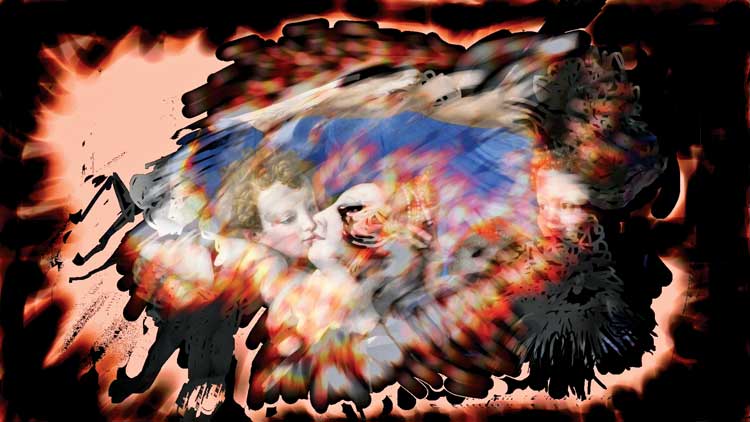
Nalini Malani. My Reality is Different, 2022. Video projection. © Nalini Malani.
So, what do participants encounter in Malani’s animation chamber? The chamber consists of a blacked-out gallery space with a nine-channel video installation and a little over 25 minutes of sound. Each channel takes as its visual sources two or three paintings from the overall selection made by the artist and each runs on a loop. For instance, Channel 4 draws on The Judgment of Paris (mid-16th century) from the German School and An Allegory with Venus and Cupid (c1545) by Bronzino. Channel 9 draws on The Auriol and Dashwood Families (c1783-87) by Johan Zoffany and The Family of Darius before Alexander (1565-67) by Paolo Veronese. These are just two examples from the nine video channels and the interplay of fragments from these paintings, shrouded, draped or cloaked in Malani’s animations is hypnotic enough. Add to that the artist’s fictional portraits of society’s marginalised and a powerful soundscape read by her long-time collaborator and friend, the actor Alaknanda Samarth (1941-2021), and spectators are immersed in a complex environment.
Malani’s videos projections overlap with animations of different lengths and are not synced. This means an endless variation of juxtapositions, permitting the spectator to create their own meaning. Malani says: “I address the spectator as an ‘active audience’, where they have the capacity to be dynamic co-creators and co-producers of meaning, rather than passive receptors.” It is a mesmerising experience to stand in the animation chamber and participate in this necessarily critical history.